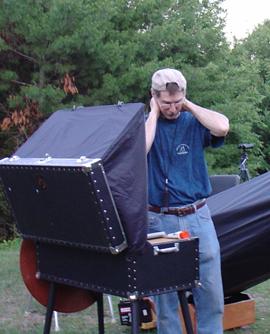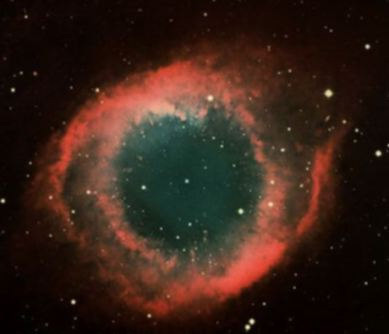




Hi. My name is Chris, and I have a problem; a planetary problem. Never mind that just a few short years ago I would never even look at these things. I started down this path unwittingly. Initially I noticed those famous Messier planetaries M27, M57, M76, and M97. I should have stopped here, but no; my so called friends, members of the Lowbrows, turned me on to some bright NGC planetaries. Pretty soon I found out I couldn’t help myself. I had to have more planetary photons. It got so bad, that at the recent Black Forest Star Party 05, after two days of serious planetary observing, on the third night I declared I would spend my remaining observing time enjoying big bright common astronomical objects. No challenge objects here, just fun and easy going observing (i.e. - No more planetaries!). After a few so-so galactic clusters of the night vision destroying kind, I found myself migrating back to getting some planetaries fixes. Not those pesky little orbs of the single arc second size, but BIG PHAT arc minute busting behemoths. Now I know what you are thinking. This guy likes his astronomical objects big and chunky. Damn straight. Bring it on.
The list below represents some huge planetary nebulae for your observing pleasure. I performed this observing run at Peach Mountain on our October 1st, 2005, Open House, figuring some of you might think these objects can’t be seen in our skies. That night was one to remember as the Lowbrows in attendance will recall. Possibly the steadiest skies I ever witnessed in a decade of observing. The seeing enabled me to see things better than at Black Forest, so perhaps it’s not a fair test of Peach Mountain. None the less, it is possible to see these objects if you choose. My Peach mountain notes follow the Black Forest notes.
| Catalog No. | Mag | Size | Coordinates - RA/Dec | Const | Remarks |
|---|---|---|---|---|---|
| NCG 7008 | 10.7 | 1.4’ | 21h00m/54^33’ | Cyg | Big and bright, though hard to find in this nondescript Cygnus star field. Peach Mtn - Fan shaped nebula with brightening to one side, 3 field stars superimposed on nebula. |
| NGC 6905 | 11.1 | 40” | 20h22m/20^06’ | Del | Blue Flash Nebula. A 15.7 central star flashes in and out of vision when observed at zenith. Peach Mtn - A very round shape planetary. A keystone of four stars helps locate this object. |
| NGC 6781 | 11.4 | 1.8’ | 19h18m/06^33’ | Aql | Very large with even density nebulosity across a round disk. Nice bright star on the edge of the disk. Peach Mtn - This one is huge, but faint (low surface brightness). |
| Intermission - Wisconsin Micro Brews, Pt 2 | |||||
| 6/22/05 - BluCreek Brewing, Altbier - So flat because it must have been bottled at a high altitude. What the purpose of this beer? | |||||
| 6/23/05 - Capital Brewery, Blonde Doppelebock - This beer is nice to look at, but what beer isn’t. | |||||
| 6/24/05 - New Glarus Brewing Co., Fat Squirrel Ale - This beer disappeared fast, just like a bunch of fat squirrels. | |||||
| Catalog No. | Mag | Size | Coordinates - RA/Dec | Const | Remarks |
| NGC 6804 | 12.0 | 1.1’x30” | 19h31m/09^13’ | Aql | Irregularly round disk with uneven brightness. 12th mag central star and bright star on edge of disk make this object noticeable. Peach Mtn - A fainter field star opposite the brighter edge star help frame this nebula. |
| NGC 7048 | 12.1 | 1.0’ | 21h14m/46^17’ | Cyg | Found just after the North American nebula, this one is faint but large. Peach Mtn - Yea this one is faint. A nice little cluster of stars off to one side with a brighter star embedded in the edge of the nebula. |
| NGC 7293 | 7.5 | 16’x12’ | 22h30m/-20^48’ | Aqr | Helix Nebula. 300ly. Biggest of big w/ low surface brightness. This has to be everyone’s favorite NGC planetary. |
| Some Challenge Objects follow: | |||||
| NGC 7139 | 13.0 | 1.3’ | 21h46m/63^47’ | Cep | Skyhound indicates this one isn’t faint enough to be a challenge object. I don’t know what planet they observe from, but any extended object that is mag 13 is a challenge in my book. |
| Abell 39 | 13.0 | 2.9 | 16h27m/27^54’ | Her | This is one planetary I gotta see. Billed as possibly the most spherical of all planetaries (John, we may need to get the 61 on this one). |
| NCG 246 | 10.9 | 4.1 | 00h47m/-11^52’ | Cet | I’ll end with this one. It’s nicely placed for fall viewing. |
OK, this is getting ridiculous. If anyone knows where I can get some therapy sign me up. Otherwise, catch me bathing my eyeball in some more planetary photons anywhere there are some clear night time skies.